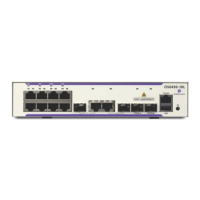OmniSwitch AOS Release 7 Network Configuration Guide March 2011 page 1113
Note that the IP address and hardware address (MAC address) are required when you add an entry to the
ARP table. Optionally, you can also specify:
• Alias. Use the alias keyword to specify that the switch acts as an alias (proxy) for this IP address.
When the alias option is used, the switch responds to all ARP requests for the specified IP address with
its own MAC address. Note that this option is not related to Proxy ARP as defined in RFC 925.
For example:
-> arp 171.11.1.1 00:05:02:c0:7f:11 alias
• ARP Name. Use the arp-name parameter to specify a name for the permanent ARP entry.
For example:
-> arp 171.11.1.1 00:2a:90:d1:8e:10 arp-name server1
Use the show arp command to display the ARP table.
Note. Because most hosts support the use of address resolution protocols to determine and cache address
information (called dynamic address resolution), you generally do not need to specify permanent ARP
entries.
Deleting a Permanent Entry from the ARP Table
Permanent entries do not age out of the ARP table. Use the no arp command to delete a permanent entry
from the ARP table. When deleting an ARP entry, you only need to enter the IP address. For example, to
delete an entry for IP address 171.11.1.1, you would enter:
-> no arp 171.11.1.1
Use the show arp command to display the ARP table and verify that the entry was deleted.
Note. You can also use the no arp command to delete a dynamic entry from the table.
Clearing a Dynamic Entry from the ARP Table
Dynamic entries can be cleared using the clear arp-cache command. This command clears all dynamic
entries. Permanent entries must be cleared using the no arp command.
Use the show arp command to display the table and verify that the table was cleared.
Note. Dynamic entries remain in the ARP table until they time out. If the switch does not receive data
from a host for this user-specified time, the entry is removed from the table. If another packet is received
from this host, the switch goes through the discovery process again to add the entry to the table. The
switch uses the MAC Address table time-out value as the ARP time-out value. Use the mac-learning
aging-time command to set the time-out value.

